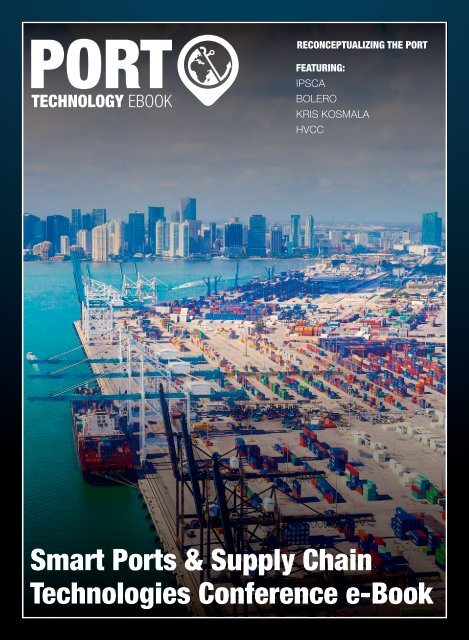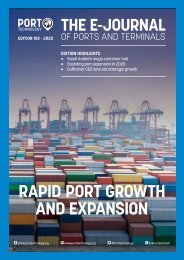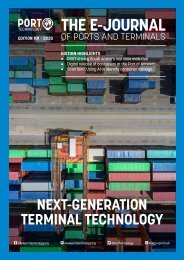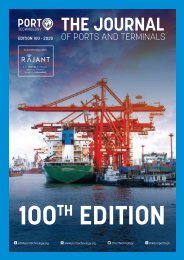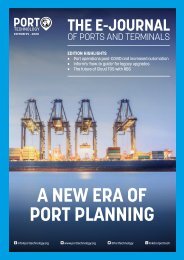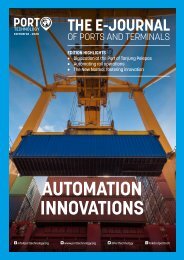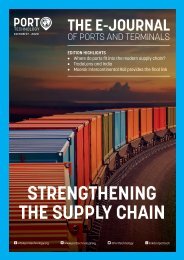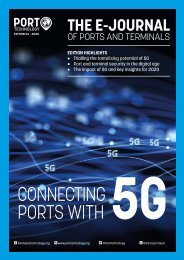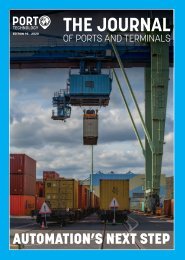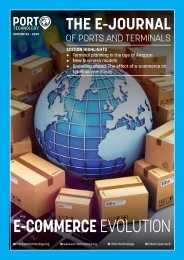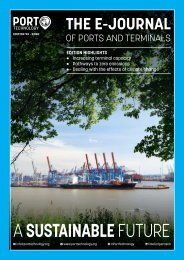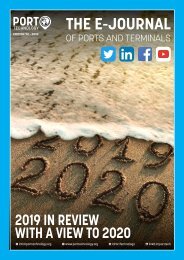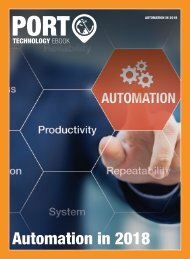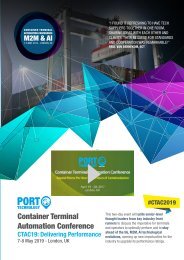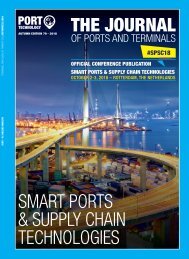#SPSC18 e-Book #3 Reconceptualizing The Port
The Reconceptualizing The Port e-Book features content from some of the top names in the port and terminal industry, including: Hans Rook and Richard Morton, International Port Community System Association Simon Streat, Bolero International Kris Kosmala, Quintiq Gerald Hirt, HVCC Reconceptualizing The Port follows the blockchain eBook ‘Blockchain in Supply Chains’ and the supply chain eBook 'Path to Intelligence'.
The Reconceptualizing The Port e-Book features content from some of the top names in the port and terminal industry, including:
Hans Rook and Richard Morton, International Port Community System Association
Simon Streat, Bolero International
Kris Kosmala, Quintiq
Gerald Hirt, HVCC
Reconceptualizing The Port follows the blockchain eBook ‘Blockchain in Supply Chains’ and the supply chain eBook 'Path to Intelligence'.
Create successful ePaper yourself
Turn your PDF publications into a flip-book with our unique Google optimized e-Paper software.
RECONCEPTUALIZING THE PORT<br />
FEATURING:<br />
IPSCA<br />
BOLERO<br />
KRIS KOSMALA<br />
HVCC<br />
Smart <strong>Port</strong>s & Supply Chain<br />
Technologies Conference e-<strong>Book</strong>
NEW EVENT<br />
CONTAINER CHAIN<br />
SUPPLY CHAIN<br />
BLOCKCHAIN<br />
SMART PORTS & SUPPLY<br />
CHAIN TECHNOLOGIES<br />
2 - 3 OCTOBER, 2018<br />
ROTTERDAM, THE NETHERLANDS<br />
TO FIND OUT MORE, CONTACT PORT TECHNOLOGY<br />
+44 (0) 20 7871 0123 OR EMAIL INFO@PORTTECHNOLOGY.ORG<br />
2 SMART PORTS & SUPPLY CHAIN TECHNOLOGIES - 2018
FROM THE<br />
EDITOR<br />
This e-book marks the third instalment in preparation for our<br />
upcoming Smart <strong>Port</strong>s & Supply Chain Technologies event<br />
and I hope this e-book aids you in getting some key insight<br />
into the conceptual framework for the conference which<br />
takes place on the 2-3 October in Rotterdam.<br />
Our contributors to this e-book have taken on the task of<br />
reconceptualising the port in a smart, interconnected global<br />
network. I think you’ll agree that each author has made a<br />
fine effort. With each paper we produce in this mould, I feel<br />
we haul ourselves forward into a new paradigm of supply<br />
chain operations.<br />
This e-book marks part one of our ‘smart ports’ offering,<br />
and will be followed by an e-book offering specific insights<br />
from some of the biggest smart ports in the world such as<br />
Singapore, Rotterdam, Hamburg and Algeciras.<br />
With that in mind, this e-book is intended to be a more<br />
conceptual offering that compliments the port e-book to<br />
follow.<br />
Our Smart <strong>Port</strong>s & Supply Chain Technologies Conference<br />
is shaping up to really stir up the industry and create some<br />
new ground, collaborative opportunities, and insight.<br />
We have several top speakers confirmed coming in from<br />
major name ports in Europe (Rotterdam, Hamburg), big<br />
international trade organizations (World Economic Forum,<br />
Netherlands Customs) and many top level intra-industry<br />
consultants and solution providers.<br />
Do check the PTI website for a definitive list and to pick up<br />
your delegate pass while there is still time.<br />
Richard Joy<br />
Editor<br />
8 jkhan@porttechnology.org X www.porttechnology.org<br />
T @<strong>Port</strong>Technology<br />
l linkd.in/porttech<br />
3 SMART PORTS & SUPPLY CHAIN TECHNOLOGIES - 2018<br />
WWW.PORTTECHNOLOGY.ORG
TRUST IN<br />
SMART PORTS<br />
A VITAL COMPONENT IN THE DIGITAL MIX<br />
Hans Rook, Chairman, and Richard Morton,<br />
Secretary General, IPCSA, UK<br />
Transparency, simplification, harmonization<br />
and standardization – these are the four<br />
pillars of trade facilitation. It would seem<br />
obvious that shipping and ports must work<br />
together to achieve these essentials and<br />
yet, in the maelstrom of the technological<br />
revolution, that simple fact can be<br />
forgotten.<br />
<strong>The</strong>re is huge pressure on us all to keep<br />
up with the rapid advances in AI, API, big<br />
data, blockchain and IoT. <strong>The</strong> exchange<br />
of electronic information is critical to the<br />
future of ports and to millions of swift,<br />
slick and efficient supply chains, of course<br />
innovation can bring improvements, but<br />
one factor remains constant throughout:<br />
Trust.<br />
TRUST IN PARTNERS<br />
However strong your technologies,<br />
however advanced your systems, however<br />
much data you gather and analyse,<br />
however clever your teams, trust remains<br />
key. You need to trust your partners before<br />
you allow them access to your systems –<br />
and vice versa. Even in our increasingly<br />
digital world, it still gets personal.<br />
We need to share data in the maritime<br />
industry in order to improve processes<br />
and the whole efficiency of the supply<br />
chain. That requires all players to be aware<br />
of what data is, and to understand the<br />
possibilities, using legacy, current and new<br />
technologies, to share that data.<br />
But what does sharing actually mean? It<br />
requires a focus on technological solutions<br />
that are neutral in essence, so that they<br />
can adapt and be futureproof as the world<br />
of information moves forward. It means<br />
ensuring the physical capability to share<br />
data via smart IT solutions. It’s human<br />
nature to get excited about new innovations<br />
but the danger of that excitement is that<br />
we can lose sight of the need for clear<br />
standards and definitions. Lego is nice to<br />
use as the ultimate example for this.<br />
Growing up we all used to play with<br />
Lego. You can buy Lego today and it still<br />
fits the Lego you bought four decades<br />
ago. That is real standardisation. New<br />
technologies tend to focus on proprietary<br />
standards and don’t use neutral,<br />
common standards. That route delivers<br />
complication, not simplification. Any<br />
strategy must consider what data is being<br />
shared, what technology can be used, and<br />
whether that technology is neutral enough<br />
to be adaptable to future developments.<br />
Sharing means sharing.<br />
PORT COMMUNITY SYSTEMS<br />
Providing neutral, trusted platforms, <strong>Port</strong><br />
Community Systems have played a critical<br />
role in the exchange of electronic data for<br />
decades. In our increasingly digital world,<br />
it is those same <strong>Port</strong> Community Systems<br />
that are perfectly placed to develop and<br />
coordinate the necessary connections.<br />
That is the biggest value of a Community<br />
4 SMART PORTS & SUPPLY CHAIN TECHNOLOGIES - 2018<br />
WWW.PORTTECHNOLOGY.ORG
System, whether it is operating within a sea<br />
port, airport or inland port or at a border<br />
crossing.<br />
Currently ports and shipping lines use<br />
UN Edifact standards, while Customs<br />
organisations favour the WCO data models<br />
and XML. While different formats, the<br />
critical factor is that the data elements<br />
used are the same (UN TDED – Trade data<br />
element directory). If the entire community<br />
is willing to share data, they need a trusted<br />
third party, a Community System, and we<br />
can’t see that changing in the future. A<br />
Community System acts as a trusted third<br />
party guardian of data, ensuring that it is<br />
never shared with those not authorised to<br />
see it.”<br />
That factor also provides added<br />
confidence in an industry concerned with<br />
cybersecurity and the threat of cyberattack.<br />
STANDARDIZATION<br />
Standardization is an issue that actually<br />
goes beyond data. For example, with<br />
regard to the definition of ‘port of arrival’,<br />
does this mean when the ship arrives in<br />
port territory (generally the ship agent’s<br />
definition) or when the ship is actually at<br />
the quayside (the customs definition)? By<br />
following the former definition, the port<br />
territory could be three hours’ steaming<br />
from the quay, and also what might be<br />
understood as the ETA in London might<br />
be a completely different interpretation in<br />
Rotterdam. It’s easy to see how messages<br />
get mixed. While we surge ahead with<br />
technology, we are often missing the<br />
operational harmonization to match it.<br />
That ‘sharing’ word comes to mind once<br />
again.<br />
<strong>The</strong> International <strong>Port</strong> Community<br />
Systems Association and its members<br />
constantly focus on innovation in order<br />
to move forward and provide customers<br />
with the advanced solutions they need<br />
in the demanding world of shipping and<br />
trade. But we never lose sight of the real,<br />
practical applications of these solutions.<br />
As an association, we are forging ahead<br />
with some unique developments, always<br />
bearing in mind that these developments<br />
must deliver significant benefits to the<br />
users – not merely switch existing paperbased<br />
processes to a screen. Below are<br />
some examples of our current initiatives:<br />
THE IPCSA BLOCKCHAIN WORKING GROUP<br />
Led by Gadi Benmoshe, CIO of the Israel<br />
<strong>Port</strong>s Company, this group is developing<br />
a functioning and workable blockchain<br />
solution for bills of lading. This is being<br />
trialled by a number of members. As<br />
trusted third parties, PCSs are uniquely<br />
placed to integrate blockchain bills of<br />
lading into their existing network systems.<br />
THE ‘NETWORK OF TRUSTED NETWORKS’<br />
IPCSA has also developed a unique<br />
programme here within which <strong>Port</strong><br />
Community Systems are able to connect<br />
and share information via a special created<br />
common shared global standard, based<br />
on API (Application Program Interface).<br />
<strong>The</strong> project is being led by Javier Gallardo,<br />
director at <strong>Port</strong>ic, Spain, and vice-chairman<br />
of IPCSA. For decades, <strong>Port</strong> Community<br />
Systems have been acting as trusted third<br />
parties for their customers, enabling<br />
communication among port companies<br />
and stakeholders through a hub-andspoke<br />
model. PCSs have long been offering<br />
authentication services, directory and<br />
delivery services, message transformation,<br />
ABOUT THE AUTHOR<br />
Hans Rook has worked in the transport<br />
and logistics sea trade sector for 48 years.<br />
He started his career at a shipping agency<br />
and, having gaining experience in all facets<br />
of import and export services, he was<br />
appointed to set up the ICT function within<br />
the company. He is one of the gurus on EDI<br />
standardization – he joined UN working<br />
groups to establish UN/CEFACT EDIFACT<br />
messages for the global sea trade industry.<br />
Richard Morton has been Secretary<br />
General of the International <strong>Port</strong><br />
Community Systems Association (IPCSA)<br />
since it was first founded in 2011 as<br />
the European <strong>Port</strong> Community Systems<br />
Association (EPCSA). In his role as Secretary<br />
General, Richard supports international<br />
organisations including the United Nations,<br />
World Customs Organization, European<br />
Commission, International Maritime<br />
Organization and many others, providing<br />
experience, expertise and knowledge in<br />
the electronic exchange of information for<br />
practical trade facilitation.<br />
and applications to their customers in their<br />
port communities. IPCSA’s Network of<br />
Trusted Networks goes further, connecting<br />
and sharing information among PCS<br />
communities.<br />
CONCLUSION<br />
Of one thing we can be sure: Global data<br />
sharing will become the norm rather than<br />
the exception. <strong>The</strong>re is added complexity<br />
when operators must trust others from<br />
other countries or regions, with different<br />
cultures and data environments. When<br />
strategies are considered in the future, we<br />
have to recognize that we are now global,<br />
and that we need to standardize with a<br />
global mindset.<br />
ABOUT THE ORGANIZATION<br />
<strong>The</strong> International <strong>Port</strong> Community Systems<br />
Association (IPCSA) was originally founded<br />
in 2011 as the European <strong>Port</strong> Community<br />
Systems Association, by six Europeanbased<br />
PCS operators. It was relaunched<br />
in 2014 as an international association,<br />
reflecting its growing membership outside<br />
Europe. Membership includes Sea and Air<br />
<strong>Port</strong> Community System Operators, Sea<br />
and Air <strong>Port</strong> Authorities and Single Window<br />
Operators.Today, IPCSA’s members operate<br />
across the world, exchanging electronic<br />
information at more than 150 sea and<br />
air ports, rail and inland waterways, and<br />
border crossing points. This equates to<br />
more than 500 million TEU and 7 billion<br />
tonnes of world trade a year, a reach of<br />
over 1 million users, and the exchange of<br />
more than 30 million messages per day in<br />
support of efficient Sea and Air <strong>Port</strong>s.<br />
ENQUIRIES<br />
website: www.ipcsa.international<br />
email: richard.morton@ipcsa.international<br />
SMART PORTS & SUPPLY CHAIN TECHNOLOGIES - 2018 5
THE LIBERATION OF PORTS<br />
FROM PAPER TO DIGITAL<br />
Simon Streat, VP Product Strategy,<br />
Bolero International, London, UK<br />
<strong>The</strong> era of the smart port will arrive<br />
very soon. Sensor technology, big data<br />
analytics and cloud-based applications are<br />
already transforming operations in port<br />
areas around the world. From Rotterdam<br />
to Shanghai to San Diego, a new kind of<br />
port is being created that employs all the<br />
technologies of the Internet of Things,<br />
obtaining the significant boosts in efficiency,<br />
asset-management and security that only<br />
radical digitisation can deliver.<br />
Yet while smart port authorities such<br />
as Hamburg or Singapore use digitization<br />
to eradicate inefficiency and speed up<br />
port operations, the insecure and wholly<br />
inefficient use of paper trade documents by<br />
carriers, corporates and banks threatens to<br />
remain a drag on progress.<br />
THE SMART PORT VOYAGE<br />
<strong>The</strong> voyage to the smart port is certainly<br />
underway. Rotterdam is looking for major<br />
efficiency gains from its collaboration with<br />
IBM to crunch data on weather, water and<br />
berthing operations. Singapore, Tallinn and<br />
Hamburg are using digital technology to<br />
slash waiting times for container-carrying<br />
trucks, and Hamburg’s ambitions extend to<br />
a doubling of its capacity by 2025 without<br />
physical expansion.<br />
As larger ships take to the sea, stocked<br />
with ever more powerful digital technology,<br />
the pressure on ports to speed up their<br />
operations is rising. <strong>Port</strong>s that fail to deploy<br />
internet of things technologies and data<br />
analytics are unlikely to cope with the new<br />
emphasis on achieving efficiency through<br />
digitization rather than increasing physical<br />
scale. Digitization can deliver big gains in<br />
capacity-planning and service-delivery<br />
by addressing specific challenges in asset<br />
management and introducing much higher<br />
levels of integration between the multiple<br />
stakeholders. <strong>The</strong> arrival of 5G connectivity<br />
will be another catalyst for the digitisation<br />
of everything related to a port.<br />
ELECTRONIC TRADE DOCUMENTS<br />
Given all the investment in smart port<br />
operations, more widespread use of<br />
electronic trade documents seems<br />
essential. <strong>The</strong> throughput of containers<br />
can be increased if importers or exporters,<br />
for example, are already using electronic<br />
bills of lading (eBLs) and digital versions of<br />
all the other documents related to trade<br />
transactions. <strong>The</strong> data that smart port or<br />
customs authorities require to establish<br />
excise payments, charges and to fulfil other<br />
legal requirements such as compliance with<br />
sanctions or safety legislation is already<br />
to hand in a digitized format in electronic<br />
trade documents, and this does not require<br />
laborious, error-prone transcription.<br />
THE END OF PAPER-BASED TRADE<br />
As smart ports take shape in the Far East and<br />
Europe, and the Gulf and North African states<br />
follow their example, it makes little sense for<br />
bills of lading and all the other documents<br />
relating to shipments to be in paper format,<br />
physically couriered around the globe.<br />
<strong>The</strong> physical transfer of trade<br />
documentation in paper form can take in<br />
excess of a month, while a secure cloudbased<br />
platform will support the completion<br />
of the exchange within a day. Automation<br />
reduces overheads and man-hours, with<br />
document transmission constrained only<br />
by the speed of the internet, rather than a<br />
courier’s expensive logistics.<br />
6 SMART PORTS & SUPPLY CHAIN TECHNOLOGIES - 2018<br />
WWW.PORTTECHNOLOGY.ORG
Digitization of trade documents also<br />
removes the age-old problems in relation<br />
to fraud, accuracy, and the tendency<br />
of paper documents to get lost. <strong>The</strong><br />
electronic version of the bill of lading (eBL)<br />
is substantially more secure since it enjoys<br />
protection from a digital signature and<br />
encryption technology similar to that used<br />
in banking for the transfer of electronic<br />
funds.<br />
ADOPTION IN THE MIDDLE EAST<br />
Electronic presentation of trade documents<br />
is already gaining acceptance among<br />
major exporters and banks in different<br />
areas of the world. It has been adopted<br />
as far afield as South America, India and<br />
Asia, with organisations as prominent as<br />
BHP and Rio Tinto using the technology to<br />
accelerate secure and trusted execution of<br />
transactions in the Far East.<br />
In the MENA (Middle East and North<br />
Africa) region, hopes are also bright for its<br />
adoption, as many governments recognise<br />
that digitization is a key element in plans<br />
to reduce economic reliance on oil and gas<br />
or commodity exports.<br />
This means that their investment in new<br />
port and maritime facilities is seen as a<br />
part of a wider digital project. This includes<br />
Egypt’s investment in a new maritime hub<br />
and industrial park at East <strong>Port</strong> Said, port<br />
upgrades in Algeria and Morocco and the<br />
giant maritime complex being constructed<br />
at Ras Al-Khair in Saudi Arabia.<br />
DIGITIZATION<br />
In Saudi Arabia and Qatar, digitization<br />
is driven by Vision 2030 masterplans,<br />
while the UAE has Vision 2021. Egypt and<br />
Jordan too have their digital strategies. It<br />
may be true that these countries’ digital<br />
economies remain proportionately very<br />
small when set against the G7 nations,<br />
but the Gulf states are not hampered by<br />
inadequate broadband connectivity or<br />
lack of ICT talent. <strong>The</strong>y also have some<br />
forward-looking regulators in the trade<br />
and finance sector and are backed up by<br />
a robust legal system and a willingness to<br />
enforce rules.<br />
Many of the region’s decision-makers<br />
in international trade have indeed already<br />
started to adopt digital platforms. SABB<br />
(Saudi British Bank), for example, is now<br />
bringing electronic trade document<br />
solutions to corporate clients, slashing<br />
transaction times and delivering major<br />
efficiency gains to all parties. In fact,<br />
many of the banks in the MENA area are<br />
increasingly open to the digitisation of<br />
trade finance. SABB’s adoption of a digital<br />
platform in 2017 was a first for trade<br />
digitization in the kingdom and a real trailblazer.<br />
CARRIERS NEED TO COME ON BOARD TOO<br />
In the MENA, as elsewhere, there is a role<br />
now for carriers to fly the flag of trade<br />
document digitization, following the example<br />
of a major container carrier in the Far East<br />
which has integrated a secure, third-party<br />
digital platform into its portal to achieve<br />
paperless exchanges of documents between<br />
all the parties concerned in shipments. <strong>The</strong><br />
documents include bills of lading, packing<br />
lists, commercial invoices, certificates of<br />
origin and other customs-related credentials,<br />
licences and inspection reports.<br />
ABOUT THE AUTHOR<br />
Simon Streat joined Bolero International as VP<br />
Product Strategy in March, 2015. With over 25<br />
years of experience in general management,<br />
sales, marketing and product leadership<br />
positions in a range of organizations including<br />
BT Group Plc, Experian and Alcatel. Prior<br />
to Bolero, Simon was Director of Global<br />
Channel Sales at Truphone and before that<br />
he was Managing Director of Experian’s UK &<br />
I SME business. Simon has direct experience<br />
of leading technology focused businesses<br />
in delivering profitable business growth.<br />
Notable accolades include successfully<br />
launching Experian’s SME business globally,<br />
launching and managing BT Openzone and<br />
two fully functional mobile operators in<br />
Spain and Italy. Simon holds a BSc from the<br />
University of Manchester in Electrical and<br />
Electronic Engineering.<br />
THE DIGITAL PLATFORM<br />
Of course, carriers alone will not convert<br />
port and customs authorities, nor<br />
conservative banks and corporates to<br />
the obvious advantages of digital trade<br />
platforms. Yet as we are propelled into<br />
the era of the smart port, it would be<br />
utterly bizarre for paper trade documents<br />
to remain as a severe bottleneck, choking<br />
off many of the dramatic gains in speed,<br />
efficiency and cost-effectiveness that<br />
everyone in world trade is seeking.<br />
ABOUT THE ORGANIZATION<br />
Established in 1998 by SWIFT and the global<br />
logistics and insurance industry, Bolero<br />
International has built a strong reputation<br />
and market leadership position in driving<br />
the digitisation of global trade. Bolero<br />
delivers secure, end-to-end, cloud-based<br />
services across the entire global supply<br />
chain. By digitising trade processes and<br />
transactions, providing greater visibility,<br />
transparency and control, Bolero is making<br />
trade safer, smarter and faster.<br />
ENQUIRIES<br />
info@bolero.net<br />
http://www.bolero.net/<br />
SMART PORTS & SUPPLY CHAIN TECHNOLOGIES - 2018 7
PORTS AND<br />
TECH STARTUPS<br />
A NEW MODEL OF VENTURE CAPITALIST<br />
Kris Kosmala, VP Asia Pacific,<br />
Quintiq, Singapore<br />
When we think about the traditional<br />
mandate of a port, we rarely associate<br />
it with funding information technology<br />
startups. While ports are oriented towards<br />
ensuring the safety of operations and<br />
minimizing risks, the world of technology<br />
startups is precisely the opposite. It<br />
features a higher than average failure<br />
rate and capital burn rates that are not<br />
for a fainthearted investor. <strong>The</strong> earlier the<br />
stage of funding, the higher the risk of not<br />
collecting any rewards.<br />
<strong>Port</strong>s intending to create their own<br />
incubators can build on the experiences<br />
gained so far from the operations of<br />
Unboxed (PSA), PorTechLA (<strong>Port</strong>s of Los<br />
Angeles and Long Beach), <strong>Port</strong>XL/Smart<br />
<strong>Port</strong> 2.0 (<strong>Port</strong> of Rotterdam), or CroNoMar<br />
(ports of Croatia). While each was started<br />
with a slightly different innovation area,<br />
their collective experience provides a<br />
reliable blueprint for other ports to follow.<br />
SMART PORT DYNAMISM<br />
Organizationally, a port keen on incubating<br />
relevant businesses needs to provide<br />
work facilities and commit to helping the<br />
startups by providing realistic technology<br />
test beds and feedback from technologists<br />
within the port. Financial support may<br />
vary, but real dollars and cents need to be<br />
budgeted and available for disbursements<br />
over the 6-12 month period of incubation.<br />
Linking a port’s incubator with nearby<br />
universities and research organizations is<br />
of importance as well. Making this linkage<br />
successful requires the incubator operation<br />
to get over any institutional constraints to<br />
involving academic staff in commercial, forprofit<br />
programs.<br />
Taking such risk does not come without<br />
possible benefits. By working in this<br />
manner, ports can actively direct startups<br />
to solve very specific problems related<br />
to operational efficiency, equipment<br />
utilization, energy consumption or<br />
workforce utilization. Solutions hatched<br />
in the incubator can be commercialized<br />
and offered to other ports. <strong>Port</strong>s inviting<br />
companies into an incubator are assured<br />
of equity ownership (ranging from 5% to<br />
20%) and a revenue cut from the sales<br />
made by the startup to ports’ partners or<br />
other ports.<br />
THE BUSINESS CASE<br />
Broadly speaking, being involved in<br />
technology financing is good for ports<br />
facing a stagnating mature market, where<br />
increased efficiency and protection of<br />
market share are central to business<br />
strategy. Gaining efficiency and smartening<br />
operations beyond merely automating<br />
means that a port can achieve more<br />
without necessarily expanding its physical<br />
size. That’s all good, but any business<br />
strategy needs a strong underpinning in<br />
rational assumptions about the business<br />
model.<br />
8 SMART PORTS & SUPPLY CHAIN TECHNOLOGIES - 2018<br />
WWW.PORTTECHNOLOGY.ORG
<strong>The</strong> business assumption behind a port<br />
becoming a technology investor is harder<br />
to define. Typical technology investors look<br />
to get a return on investment, but they also<br />
contribute their business and technical<br />
expertise, help with introductions into<br />
different platforms, and generally open<br />
doors for the startup.<br />
In general, ventures are expected to lose<br />
money meaning write-offs on the balance<br />
sheet. Not a pretty sight for a public<br />
company. Justifications for bleeding cash<br />
on a non-core business may wear thin with<br />
port investors, even if a port is owned by<br />
local government and the cost of running<br />
the incubator can be shared.<br />
THE TECHNOLOGICAL CASE<br />
<strong>The</strong> technological assumption behind<br />
funding startups, rather than developing<br />
and testing solutions themselves, relates<br />
to the explosive progress in technologies<br />
applicable to port operations.<br />
<strong>The</strong>se include a world of intelligent<br />
interconnected sensors (also known as<br />
the Internet of Things), autonomous<br />
vehicles, geo-location services, multiple<br />
areas of artificial intelligence, digital<br />
simulations (digital twins), and advanced<br />
robotics.<br />
Solutions are expected to process ship<br />
traffic more efficiently, reduce harmful<br />
emissions from port equipment and ships,<br />
improve shipping documentation, or<br />
gather environmental data from the sea<br />
and air. <strong>The</strong> list goes on and on.<br />
Learning about these technologies<br />
and testing their applicability would<br />
easily consume budgets and the time<br />
of port IT and operations departments,<br />
not to mention lead to a subconscious<br />
injection of unnecessary bias into the<br />
creative technology application process.<br />
In the incubator scenario, startups run<br />
separately from the internal organization,<br />
but controlled by the port, they can help<br />
bring some of their leftfield thinking into<br />
the creation process, as well as make a<br />
real difference faster than port could make<br />
doing it all by themselves.<br />
THE DIGITAL CASE<br />
Capturing opportunities resulting<br />
specifically from digital integration benefits<br />
ports by allowing them to turn into a<br />
different type of service provider. Not a<br />
purveyor of physical services like towage<br />
or crane operations, but a data service<br />
provider. Digitalization of port activities<br />
where new services either replace or<br />
augment traditional port services provides<br />
opportunities to rethink a port’s traditional<br />
business model.<br />
<strong>The</strong> current port experience is largely<br />
geared to transporters getting their cargo<br />
to and from the vessel as efficiently as<br />
possible. In the digital-driven future, entire<br />
supply chains flowing through the port will<br />
be propelled by technology, starting before<br />
the arrival of cargo to the port, online<br />
during the journey to/from the airport, and<br />
upon arriving at the next destination.<br />
CONCLUSION<br />
<strong>The</strong> strategic goal of implementing<br />
an incubator should go beyond mere<br />
efficiency improvements and focus on<br />
a holistic, long term ‘smart port’ within<br />
an ‘intelligent supply chain’ strategy,<br />
where insights are distilled from data<br />
and smart applications, enabling ports to<br />
transition from traditional business models<br />
to newer, bespoke models. <strong>The</strong> much<br />
larger opportunity arising out of sharing<br />
incubator-generated insights and digital<br />
innovation between port communities and<br />
even competing ports has not yet been<br />
fully unexplored to establish a repeatable<br />
template for all ports to follow. <strong>The</strong> nature<br />
of the business poses some challenge, as<br />
true segment-wide collaboration requires<br />
integration between the supply and<br />
ABOUT THE AUTHOR<br />
Kris Kosmala brings many years of extensive<br />
global experience as a business operations<br />
executive in the services and technology<br />
industries. He is a senior member of<br />
management team at Quintiq, a software<br />
company specializing in development<br />
and provision of advanced mathematical<br />
optimization software used in all aspects of<br />
planning and scheduling.<br />
ABOUT THE ORGANIZATION<br />
Too often in large organizations, planners<br />
and managers are disconnected in their<br />
planning decisions. Many organizations<br />
are overwhelmed by the number of<br />
spreadsheets they’re using to make sense<br />
of it all. Quintiq brings it all together. It’s<br />
demand side actors in the transport and<br />
logistics sector, and assimilation of data not<br />
only from logistics firms and suppliers and<br />
distributors, but also their clients.<br />
Having an open lab accessible to<br />
all port collaborators as a part of the<br />
incubator could personalize collaborators’<br />
experiences and provide real-time data<br />
to facilitate continuous improvement.<br />
Perhaps the most important role of the<br />
lab is to test the viability of systems for<br />
implementation within the infrastructure<br />
existing within an organization for each<br />
collaborator. It provides proof-of-concept<br />
prior to scaling to other parts of the<br />
collaboration network.<br />
In summary, ports acting as early tech<br />
investors represent a fresh initiative<br />
to navigate a changing world. Early<br />
experiences show that ports must lead<br />
the evolution and application of new<br />
technologies within and outside of the<br />
port, as their unique place in the complex<br />
supply chain gives them the best position to<br />
influence how supply chains are executed<br />
and how they perform.<br />
one planning system to cover every aspect<br />
of planning, from long-term strategic plans<br />
to short-term schedules and disruption<br />
management. Every department and every<br />
user can customize the interface and the<br />
information visible to suit preferences and<br />
requirements. Plans are updated in realtime<br />
for company-wide transparency and<br />
collaboration.<br />
ENQUIRIES<br />
Dassault Systèmes B.V.<br />
Utopialaan 25,<br />
5232 CD 's-Hertogenbosch,<br />
P.O. Box 264,<br />
5201 AG 's-Hertogenbosch,<br />
<strong>The</strong> Netherlands<br />
Tel: +31 (0) 73 691 0739<br />
W: http://www.quintiq.com<br />
SMART PORTS & SUPPLY CHAIN TECHNOLOGIES - 2018 9
PORT PARTNERSHIPS<br />
IN PRACTICE<br />
Gerald Hirt, Managing Director,<br />
HVCC Hamburg Vessel Coordination Center, Hamburg, Germany<br />
Two trends have defined container<br />
shipping in the past decade. To start with,<br />
bigger and bigger ships were built at an<br />
unprecedented pace and the result was<br />
systemic overcapacity, which triggered<br />
various consolidations among shipping<br />
companies. <strong>The</strong> second is that port<br />
authorities and terminal operators have<br />
been faced with major challenges owing to<br />
this development.<br />
Upgrading an existing quay wall to<br />
accommodate new gantry crane models,<br />
for example, requires much more time<br />
for preparation and construction than the<br />
construction of an 18,000 TEU ship.<br />
New requirements also came into<br />
effect on navigating estuaries, on turning<br />
circles and approach manoeuvres, lines<br />
arrangement and the condition of bollards.<br />
It became necessary to manage the heavy<br />
operational peak times in processing megaships<br />
and in the distribution of the cargo to<br />
feeder and inland ships, trains and trucks.<br />
Meanwhile one important element<br />
faded into the background at several ports,<br />
even though it would offer additional<br />
scope for optimisation. Namely, closer<br />
collaboration among each other, and with<br />
all involved parties. This article explains<br />
how the challenges resulting from the<br />
changing size of ships were recognised<br />
early on in Hamburg and how they have<br />
been successfully mastered using a unique<br />
model, the Hamburg Vessel Coordination<br />
Center (HVCC).<br />
THE HAMBURG WAY: PARTNERSHIP<br />
A project entitled the Feeder Logistics<br />
Center (FLC) was launched by Hamburger<br />
Hafen und Logistik (HHLA) back in 2004. <strong>The</strong><br />
motivation behind this project was reducing<br />
the number of calls to terminals that a<br />
feeder ship had to make. For commercial<br />
feeders, the average was four terminal calls<br />
per port visit, both at the neighbouring<br />
HHLA and Eurogate container terminals,<br />
as well as other terminals in the port area.<br />
As a result, HHLA’s competitors, Eurogate<br />
Container Terminal Hamburg (CTH) and<br />
the commercial feeder operator Unifeeder,<br />
were also persuaded of the benefits of<br />
adopting a central feeder coordination<br />
strategy.<br />
HHLA and Eurogate launched an<br />
independent company called Hamburger<br />
Feeder Logistik Zentrale (FLZ) or Feeder<br />
Logistics Center (FLC) in 2009. For the<br />
shipping companies and customers at the<br />
<strong>Port</strong> of Hamburg, the FLC represents a<br />
neutral platform with direct access to any of<br />
the relevant terminals’ operating systems.<br />
<strong>The</strong> FLC assists shipping companies 24<br />
hours a day with berth availability and<br />
stowage planning. It also ensures that<br />
pilots, tugs and boatmen are ordered on<br />
time. This allows the shipping companies<br />
to concentrate on their core business, and<br />
the partner terminals benefit from having<br />
the FLC on hand as a 24-hour contact<br />
10 SMART PORTS & SUPPLY CHAIN TECHNOLOGIES - 2018<br />
WWW.PORTTECHNOLOGY.ORG
partner for feeder ship handling queries.<br />
<strong>The</strong> FLC checks work programmes and<br />
stowage plans on behalf of the terminals,<br />
thereby reducing waiting times for ships.<br />
Coordination of feeder ship calls by the<br />
FLC central interface thus ensures that the<br />
capacity utilisation of berths is optimised.<br />
Today, the FLC coordinates around 4,000<br />
terminal calls per year as a department of<br />
the HVCC, including calls by inland vessels<br />
since 2016.<br />
As a result of the growth of containerships,<br />
cruise ships, bulkers and ConRo ships,<br />
it seemed only logical to expand the<br />
coordination of the FLC. In order to better<br />
manage the arrivals and departures and<br />
regular calls by major ships at the port’s 30<br />
or so terminals, and to tailor them more<br />
closely to the nautical requirements of a<br />
tidal port, work began in 2012 on developing<br />
a concept for what is now known as the<br />
Nautical Terminal Coordination (NTC).<br />
Three years later, the FLC was renamed<br />
the Hamburg Vessel Coordination Center<br />
(HVCC). <strong>The</strong> HVCC is comprised of the FLC<br />
and the NTC departments.<br />
LEARNING FROM AVIATION<br />
When developing the concept for the NTC,<br />
experiences from other industries aiming to<br />
respond to similar situations were analysed.<br />
It seemed natural to take a closer look at<br />
the world of aviation. <strong>The</strong> increase in traffic<br />
generally, but also the evolution of very large<br />
aircraft such as the Airbus A380 required<br />
that hub airports put major infrastructure<br />
Figure 2: Feeder coordination by the FLC<br />
Figure 1: HVCC organisational structure<br />
in place and adapt operational processes.<br />
In some cases, it was possible to develop<br />
whole terminals or add additional runways<br />
to accommodate these innovations.<br />
One trailblazer in Airport Collaborative<br />
Decision-Making (ACDM) is Zurich Airport,<br />
where all the stakeholders involved in<br />
airport operations work together in an<br />
airport steering room and share relevant<br />
data. Direct and open communication forms<br />
the basis for this concept. Disruptions in<br />
operations are solved within minutes at a<br />
central conference table.<br />
Monthly stakeholder meetings provide<br />
an example of the open communication<br />
of defined KPIs, always with the aim<br />
of continually improving processes.<br />
Participation in the ACDM is voluntary and<br />
some stakeholders, including several highprofile<br />
airlines, were not involved from the<br />
start. <strong>The</strong> example of Zurich shows how<br />
optimising the total value added of limited<br />
infrastructure can be beneficial, instead of<br />
merely fulfilling the individual interests of a<br />
specific stakeholder in a specific situation.<br />
INSPIRING PARTNERS TO PARTICIPATE<br />
Today, the NTC’s role is to act as the central<br />
operating contact partner for shipping<br />
companies and customers of the <strong>Port</strong> of<br />
SMART PORTS & SUPPLY CHAIN TECHNOLOGIES - 2018 11
Figure 3: <strong>The</strong> NTC’s value added services<br />
12 SMART PORTS & SUPPLY CHAIN TECHNOLOGIES - 2018<br />
WWW.PORTTECHNOLOGY.ORG
Hamburg when it comes to the arrival and<br />
departure of their ships. <strong>The</strong> NTC monitors<br />
each ship on its rotation through Northern<br />
Europe and assists shipping companies and<br />
brokers in planning their vessels’ passage<br />
from the previous port to the <strong>Port</strong> of<br />
Hamburg, as well as their vessel’s departure<br />
from the port.<br />
For its partner terminals, the NTC pools<br />
all the different operational information to<br />
create a comprehensive traffic overview.<br />
This enables it to detect conflicts early on<br />
and develop solutions that the NTC discusses<br />
with the stakeholders involved. On behalf<br />
of the terminals, the NTC takes charge of<br />
communications with the Hamburg Vessel<br />
Traffic Service Centre and the Elbe pilots and<br />
is also available 24 hours a day as a point of<br />
contact for the authorities and pilots.<br />
<strong>The</strong> challenge in setting up the NTC was<br />
to convince stakeholders of the added<br />
value inherent to such an organisation.<br />
One of the concerns raised repeatedly by<br />
shipping companies at the outset was that<br />
they knew exactly where their ships were.<br />
Terminal operators also explained that<br />
they knew exactly when the ship had been<br />
handled. However, the HVCC/NTC concept<br />
enjoyed great support from the start from<br />
the public authorities that had called for<br />
proper centralised operational coordination<br />
and delineated its role as guaranteeing<br />
navigational safety on the river and in the<br />
port. This prevented them from having to<br />
deal with coordinating traffic with shipping<br />
companies and terminals, which was timeconsuming<br />
and geographically extensive.<br />
Today, the NTC’s services are used by<br />
almost all container-shipping companies<br />
visiting the terminals with mega-ships.<br />
<strong>The</strong>re are also intensive partnerships with<br />
ship operators, Carnival Maritime’s Fleet<br />
Operations Center and the Grimaldi Group,<br />
for example. <strong>The</strong> NTC’s services are financed<br />
by a number of terminals, including HVCC<br />
shareholders HHLA and Eurogate, as well<br />
as the Hansaport, Unikai and Cruise Gate<br />
Hamburg.<br />
Routes for the around 250 major ships per<br />
month approaching Hamburg, for example<br />
from Gibraltar, are plotted automatically<br />
by specially customised software. Shipping<br />
companies provide the NTC with their<br />
coastal schedules so that the software can<br />
provide an ongoing target or an actual<br />
comparison. <strong>The</strong> NTC is also in direct contact<br />
with some of the previous ports to integrate<br />
them into NCT planning, in particular for<br />
estimated time of departure and outgoing<br />
draught at the previous port. Vice versa, the<br />
NTC then provides the same information<br />
of vessels in Hamburg to their next port of<br />
call. On the basis of this information, and in<br />
combination with the parallel planning of<br />
outbound ships with the partner terminals<br />
in Hamburg and the relevant environmental<br />
data such as tide and wind forecasts, the<br />
NTC creates a precise plan for the passage<br />
of each shipping company’s vessels, long<br />
before the vessel is on the Elbe approach.<br />
This plan comprises recommendations<br />
in terms of speed and draught for transit<br />
towards Hamburg, as well as in-depth<br />
nautical and water-traffic-related data.<br />
Passage plans are updated in the event<br />
of changes and provided to the shipping<br />
companies. All information compiled by<br />
the NTC can be viewed in real time by the<br />
partner terminals via a terminal dashboard<br />
so that all stakeholders can work using the<br />
same data at the same time.<br />
ADDED VALUE IN PORT PARTNERSHIP<br />
<strong>The</strong> value added for stakeholders can be<br />
summarised as follows:<br />
• Optimised approach for ships coming<br />
from the previous port. This minimises<br />
bunker costs for the shipping companies<br />
and improves their carbon footprint<br />
• Terminal operators in the previous port<br />
in Hamburg and in the next port of call<br />
can optimise the use of their resources<br />
on the basis of a coordinated, consistent<br />
operational perspective. This also<br />
reduces costs and improves the carbon<br />
footprint of the terminal operator, and<br />
furthermore, the shift manager at the<br />
terminal can also focus on the processes,<br />
rather than having to also deal with<br />
issues related to coordinating water<br />
traffic<br />
• <strong>The</strong> authorities can largely focus on their<br />
own function and on the execution of<br />
the current traffic situation<br />
• Other stakeholders can also benefit<br />
from a long term, continuously-updated<br />
overview<br />
SUMMARY AND OUTLOOK<br />
After the launch of the HVCC, questions<br />
were often asked about the cost and benefit.<br />
With each passage plan produced by NTC<br />
or feeder coordinated within the <strong>Port</strong> of<br />
Hamburg by FLC doubts gradually subsided.<br />
A major prerequisite for the success of a<br />
project like this is the insight and readiness<br />
of terminal operators not only to adapt<br />
terminal hardware and infrastructure, but<br />
also to invest in process optimisation. HHLA<br />
and Eurogate recognised this necessity<br />
when they set up the FLC 13 years ago and<br />
are taking the next logical step with the NTC.<br />
Meanwhile, a growing number of<br />
stakeholders is ready to share some of their<br />
data, consequently putting their individual<br />
interests on the back burner.<br />
HVCC’s aim is to extend the scope<br />
of collaboration further in the years to<br />
come. <strong>The</strong>refore, HVCC want to integrate<br />
more terminals and carriers in the scope<br />
of planning, convince more stakeholders<br />
to participate and even collaborate with<br />
competing ports. In a first pilot-project,<br />
HVCC started sharing data with the <strong>Port</strong> of<br />
Rotterdam, exchanging relevant operational<br />
data for vessels going from Hamburg to<br />
Rotterdam and vice versa, using a defined<br />
port call standard. Further, HVCC participate<br />
in the follow-up project of the Sea Traffic<br />
Management Project (STM) and put forward<br />
a project idea to explore the possibility of a<br />
data-sharing platform for all European ports.<br />
Apart from these innovative ideas, HVCC<br />
also aims to establish partnerships and<br />
direct interfaces with shipping companies<br />
(mainliners, feeders and barge operators) for<br />
exchanging relevant data and passage plans.<br />
Further, HVCC, local authorities and pilots<br />
associations continuously working together<br />
to extend the scope of exchanging data,<br />
which is also a good example of collaboration<br />
between private and public bodies.<br />
In this way, HHLA and Eurogate will<br />
continue to blaze a trail of innovation for<br />
digitization and vessel coordination not only<br />
in the <strong>Port</strong> of Hamburg.<br />
ABOUT THE AUTHOR<br />
Gerald Hirt served two years in the Navy,<br />
then studied seaborne transport and port<br />
management at the University of Applied<br />
Sciences in Oldenburg, graduating with a<br />
degree in industrial engineering. Following a<br />
period of training at the shipping company<br />
P&O Nedlloyd, he began his career with the<br />
HHLA Group at HPC Hamburg <strong>Port</strong> Consulting<br />
in 2003. Mr Hirt has been Operations<br />
Manager at HVCC since November, 2012.<br />
In this role he expanded the portfolio of<br />
services for the Feeder Logistics Center<br />
(FLC) and developed the Nautical Terminal<br />
Coordination (NTC). In June 2017, he became<br />
Managing Director of HVCC.<br />
ABOUT THE ORGANIZATION<br />
<strong>The</strong> Hamburg Vessel Coordination Center<br />
(HVCC) is a joint venture between the two<br />
container terminal operators in the <strong>Port</strong> of<br />
Hamburg, Hamburger Hafen und Logistik<br />
(HHLA) and Eurogate Container Terminal<br />
Hamburg (CTH). Terminals and shipping<br />
companies can make use of its operational<br />
coordination services for the arrival of ships in<br />
the <strong>Port</strong> of Hamburg, routes around the port<br />
and departure after handling - whether for<br />
container mega-ships, bulkers, cruise ships,<br />
feeders or inland vessels. Furthermore, HVCC<br />
acts a central communication interface to the<br />
Hamburg Vessel Traffic Service Centre and<br />
the Elbe pilots.<br />
ENQUIRIES<br />
Email: hirt@hhla.de<br />
SMART PORTS & SUPPLY CHAIN TECHNOLOGIES - 2018 13
SMART PORTS &SUPPLY<br />
CHAIN TECHNOLOGIES<br />
2 - 3 OCTOBER 2018, ROTTERDAM<br />
CONTAINER CHAIN - SUPPLY CHAIN - BLOCKCHAIN<br />
LINKING<br />
THE<br />
SUPPLY<br />
DOWNLOAD<br />
AGENDA ON PTI<br />
WEBSITE<br />
NOW!<br />
CHAIN<br />
w WWW.PORTTECHNOLOGY.ORG<br />
l LINKD.IN/PORTTECH<br />
T PORTTECHNOLOGY


